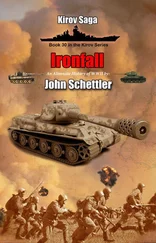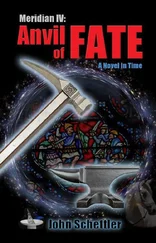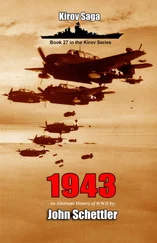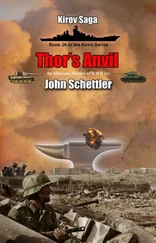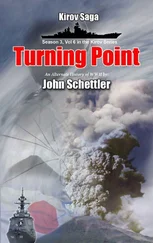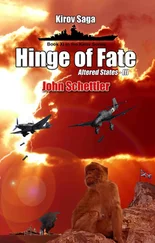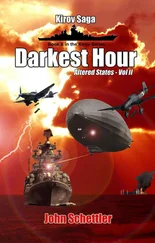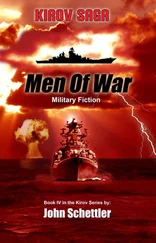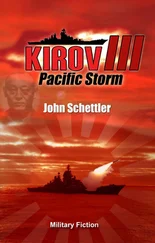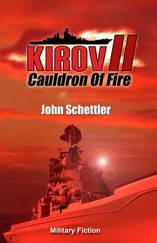John Schettler - Kirov
Здесь есть возможность читать онлайн «John Schettler - Kirov» весь текст электронной книги совершенно бесплатно (целиком полную версию без сокращений). В некоторых случаях можно слушать аудио, скачать через торрент в формате fb2 и присутствует краткое содержание. Жанр: Фантастика и фэнтези, Альтернативная история, на английском языке. Описание произведения, (предисловие) а так же отзывы посетителей доступны на портале библиотеки ЛибКат.
- Название:Kirov
- Автор:
- Жанр:
- Год:неизвестен
- ISBN:нет данных
- Рейтинг книги:5 / 5. Голосов: 1
-
Избранное:Добавить в избранное
- Отзывы:
-
Ваша оценка:
- 100
- 1
- 2
- 3
- 4
- 5
Kirov: краткое содержание, описание и аннотация
Предлагаем к чтению аннотацию, описание, краткое содержание или предисловие (зависит от того, что написал сам автор книги «Kirov»). Если вы не нашли необходимую информацию о книге — напишите в комментариях, мы постараемся отыскать её.
Kirov — читать онлайн бесплатно полную книгу (весь текст) целиком
Ниже представлен текст книги, разбитый по страницам. Система сохранения места последней прочитанной страницы, позволяет с удобством читать онлайн бесплатно книгу «Kirov», без необходимости каждый раз заново искать на чём Вы остановились. Поставьте закладку, и сможете в любой момент перейти на страницу, на которой закончили чтение.
Интервал:
Закладка:
Fedorov was silent, realizing now that every bit of information he revealed to Karpov was dangerous-that Karpov himself was dangerous, and without the Admiral available as a countervailing force, there was no telling what he might do next.
Chapter 24
On the 23rd of July, the warm sun dappled the waters of Willoughby Bay and Hampton Roads where the carrier USS Wasp, moved with the gentle incoming tides at dock seven of the American naval operations base at Norfolk, West Virginia. The stevedores had been working all day, loading long wooden crates up on to the ship where they were quickly unpacked to reveal several squadrons of Army P-4 °C fighters earmarked for deployment at the new American airfields on Iceland. Curious sailors watched the planes being brought aboard with three PT-17 trainers, all assigned to the 33rd Pursuit Squadron out of Mitchel Field, on Long Island, New York. And with them came a gaggle of Army Air Force pilots, saluting as they came aboard reporting for temporary duty on the big navy ship, and seeming just a little bit out of their element.
The Wasp was a scaled-down version of the Yorktown class carrier, but lighter, with smaller engines, virtually no armor, and a displacement under 20,000 tons with full load. The Navy had been looking for ways to cut corners while adding another carrier to its inventory, trying for a smaller ship that still had the same aircraft capacity of the larger Yorktown class. Wasp was the result. She wasn’t rigged for battle yet. Most of her VF-7 flyboys would sit this one out on nearby airfields, as her mission was just a ferrying operation. A few days later, she cast off her moorings and eased quietly away from her berthing to slip out into Chesapeake Bay and make her way into the North Atlantic. There she rendezvoused with the heavy cruiser Vincennes, and destroyers O'Brien and Walke for the run up to Iceland.
Along the way she encountered a larger US task force also bound for Reykjavik. Task Force 16 was led by the hulking presence of the battleship Mississippi with cruisers Quincy and Wichita, and five other destroyers. They were escorting three transport ships and a naval maintenance ship, Semmes, carrying Army Air Corps gear and supplies, heavy road building equipment, and other personnel assigned to duty as America took up its watch on this distant, cold outpost. The Marines were already there, setting up in the abandoned Nissen huts the British had left them, but they needed planes to provide air cover and secure their lodgment on the island. As Yorktown was still down in the Caribbean, Wasp got the job.
Now, on the morning of August 5th, she and her escorts were just a long day’s cruise from Iceland at the leisurely speed of 15 knots they were making. Wasp signaled farewell to the Mississippi, and angled away, out to sea where she could get some maneuvering room, turn into the wind, and begin launching those Army P-40s. The planes would then fly into Reykjavik on their own, a little over 400 miles to the northeast.
When the P-40s were spotted on the flight line, the navy crewmen razzed and called to their army brethren, telling them that now they would finally learn what it takes to fly off a flattop. As the first plane spun its engines up to full power and was flagged for takeoff, the sailors hooted and cheered when they saw the P-40 dip and finally rise into the sky. Then, one by one, the other twenty-nine fighters were spotted and launched, until the whole wing of thirty were circling noisily overhead. When they had assembled into their squadrons and sub flights, Captain Jim Reeves aboard Wasp radioed his best wishes and bade them farewell. The planes started north by northeast on a heading of about 45 degrees and slowly winged away toward the horizon.
“Message, Captain,” said a signalman.
“What is it, Yeoman?”
“It says to look out for a German raider exiting the Denmark Strait, sir.” The yeoman looked down at his signal decode, reading it now. “Presume hostile and very dangerous. Proceed with caution.”
“A German raider? I thought the limeys had everything under control out here. Well, there’s nothing those Army flyboys can do about it. They’re not even armed. But signal them to be on the lookout, just in case. Maybe we can spot the damn thing and send in the Mississippi to see about it.”
“Aye, sir.”
Minutes later the American planes appeared on Rodenko's long-range air detection radars aboard Kirov, and he immediately notified the Captain. “Con, radar air contact bearing on our position, speed one-eight-five at 10,000 feet, range 180 kilometers I read a large group of aircraft, sir, possibly twenty-five or thirty discrete contacts.”
That got the Captain's attention immediately. He moved quickly to Rodenko’s side looking at the scope, his eyes dark and serious. “Chief Orlov, bring the ship to battle stations. Mister Samsonov, ready on the S-300 SAM system.” This was the same long-range missile-defense system that the Admiral had used so effectively against the first British strike launched by Victorious and Furious three days ago. The Captain thought to get off a missile barrage as soon as possible, before the enemy had a chance to close with his position. There would be no repeat of the near run torpedo that had nearly struck the ship.
As he gave the order, Fedorov turned, the anxiety clear on his face. He had been reading more about the American presence in the North Atlantic and knew what these planes were and where they were bound. “Excuse me, sir,” he called, but Karpov waved him off.
“Not now, Mister Fedorov, this is a man's work.”
Fedorov ignored the insult, for he knew he had to speak. “Sir, this is not a strike wave!” he said emphatically. “These are the American P-40 fighters that I told you about earlier. They are simply being transferred from the carrier to their bases in Iceland. They are unarmed, sir!”
Karpov scowled at him. “And how might you know this? Simply because it is written in that book of yours? You expect me to put this ship and its crew at risk? The British may have contacted the Americans and advised them of our position. The history you are reading may have changed, Mister Fedorov. You were just worrying about that a moment ago. So don't bother me with these silly details, we have another battle to fight. If you are afraid of wolves, don’t go to the woods, but that is where we find ourselves.”
The Captain ordered Samsonov to begin programming his barrage, locking acquisition radars onto the targets. “This is a large group of planes,” he said. “I want no mistakes here. I assume you have completed your maintenance checks on these missiles?”
“We have, sir,” Samsonov was sitting upright in his seat, his back and shoulders taut, eyes bright, his hands quickly adjusting the dials and switches of his Combat Information Center. He turned and gave an order to a junior mishman, watching until he was satisfied the command had been carried out properly. Karpov could see the heat of battle was on him, and it was exactly why Samsonov was the perfect warrior for a situation like this. He didn’t think, he simply acted. He was like a spring in a well crafted mechanism, and would do his job the instant Karpov pushed on the right lever.
Rodenko interrupted, calling out a new target. “Con, I have surface contact, extreme range, reading four ships bearing two-two-five, speed approximately 20 knots.”
“Captain-” Fedorov tried again, but Karpov spun about, pointing at him.
“There,” he said starkly. “What are these ships doing, Mister Fedorov, delivering milk?”
“That will be the carrier Wasp and her escorts. They should be turning about soon and heading south. They pose no threat, sir.”
“They most certainly will pose no threat when I have finished with them,” said Karpov.
Читать дальшеИнтервал:
Закладка:
Похожие книги на «Kirov»
Представляем Вашему вниманию похожие книги на «Kirov» списком для выбора. Мы отобрали схожую по названию и смыслу литературу в надежде предоставить читателям больше вариантов отыскать новые, интересные, ещё непрочитанные произведения.
Обсуждение, отзывы о книге «Kirov» и просто собственные мнения читателей. Оставьте ваши комментарии, напишите, что Вы думаете о произведении, его смысле или главных героях. Укажите что конкретно понравилось, а что нет, и почему Вы так считаете.

